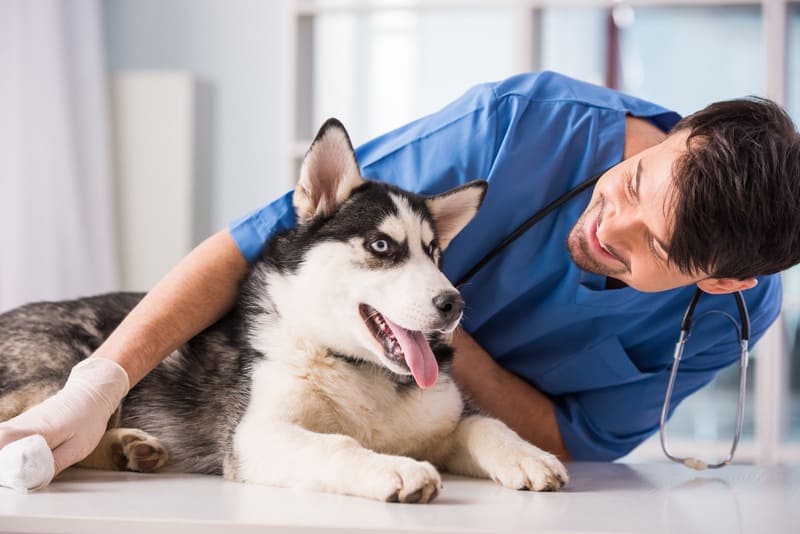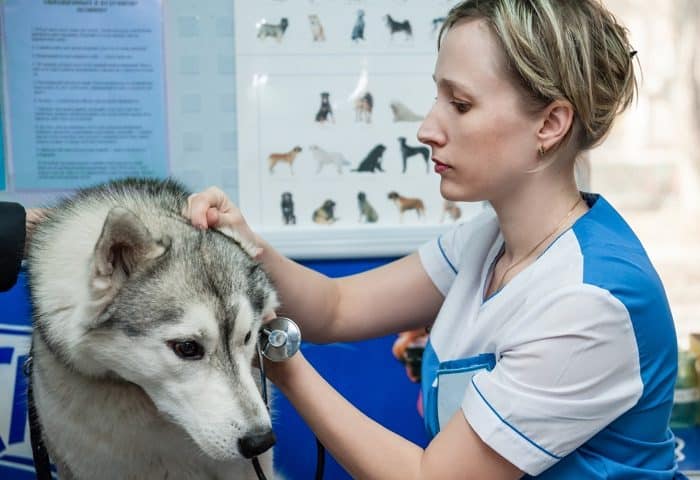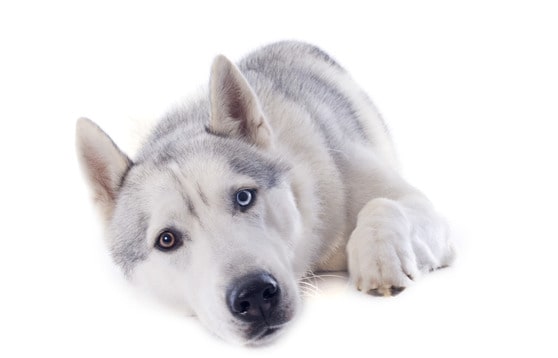
Owning a Siberian Husky puppy is like owning a cute fur-ball.
Vets suggest neutering and spaying Huskies at 6 to 9 months. However, there is no scientific backing on this age limit. You can get your husky neutered earlier than 3 to 6 months as well. However, According to some experts, early neutering or spaying may increase the risk of hip dysplasia, noise phobias, as well as aggravated sexual behavior in your dog.
But what exactly is neutering or spaying? It’s the removal of reproductive organs of a male or female animal to discourage off-springs. Since it’s a surgical process, many Husky owners find it’s a hard pill to swallow.
The Best Age to Neuter or Spay Your Husky Puppy
No husky owner looks forward to raising an unwanted litter. To curb this problem before it even starts, neutering or spaying is the best option. Now the question arises, how soon should you neuter or spay your husky puppy?
The best age to neuter or spay your husky puppy is 6 to 12 months. Although you can neuter or spay your husky puppy at any age, it’s best if you get it done sooner than later.
Neutering also keeps many health issues at bay and affects your dog’s behavior by making it less aggressive. So, whether you bring home a pup or an adult Husky, you can get them both neutered and spayed. There is a chance that a spayed female husky will still show signs of being in heat like a period or attracting other male dogs. However, it will not be able to reproduce.
Most shelters even neuter their puppies at four months, before they are put up for adoption. The reason behind this practice is that potential pet adopter wants to avoid the hustle and prefer to get an already neutered puppy.
This article will cover all the essential points regarding spaying and neutering, the care after, and how the procedure affects your husky puppy.
What is the Difference between Spaying and Neutering?
Although the term neutering applies to both male and female dogs, it’s most commonly used for castration, a surgical process to remove a male dog’s testicles. Although male dogs can’t reproduce after neutering, they may still exhibit breeding instincts such as humping. However, this depends on the age of the dog.
Similarly, spaying is the surgical process to remove a female dog’s ovaries and uterus; it’s also known as an ovariohysterectomy.
If you have an aggressive female dog, there is a major possibility that after spaying, she will become less aggressive.
How are Dogs Neutered?

We know you love your puppy and can’t really see it in pain, but you don’t need to worry as the procedure of neutering is totally safe and painless. Most Vets use injection or inhalation to put the dog under. After that, the procedure is performed without any disruptions.
The incisions during the surgery are made at areas depending on the age and maturity of your Husky. For an adult dog, the incision is made in front of the scrotum, at the base of the penis. For a puppy, however, the incision is done in the scrotal sac. In the case of an undescended testicle, the incision is made in the stomach as well.
The vet will either use skin glue, absorbable stitches, or even surgical staples to close the incisions. All the choice depends on the vet’s reference and also on the age of the puppy. All in all, it’s a procedure that will only help your Husky have a healthier life.
Why Should You Spay/Neuter Your Husky?
Other than the self-evident answer of unwanted litter, there are many other reasons why a puppy should be neutered or spayed. Here are a few to help you understand why you should opt for the procedure sooner than later.
1. Spaying your female Husky decreases the chance of breast cancer and aids your husky to have a healthier life. With neutering, you reduce the risk of testicular cancer in male dogs. Since these diseases are life-threatening, neutering and spaying might just be able to save your puppy’s life.
2. Spaying and neutering also keep uterine infections at bay, giving your Husky a healthier life in general.
3. Reduce aggressiveness. A husky that hasn’t been spayed or neutered is comparatively more aggressive and has territorial issues than one who has been neutered and spayed. By opting for sterilization, you are ensuring that you take home a less aggressive and amiable pet.
4. Unwanted litter. Many shelters and vets euthanize adult Huskies as they can’t deal with unwanted litter. So, neutering saves lives as well as ensures a healthy pup. It also allows you to have uncomplicated and long companionship with your furry friend.
What happens if you neuter/spay your dog too early?
Early neutering and spaying can have an adverse effect; hence the suggested age of 3 to 6 months has been set for neutering Siberian Huskies. These adverse effects may include hip dysplasia, noise phobias, as well as aggravated sexual behavior.
How to Care for a Husky After it’s Neutered/Spayed?
At least two weeks of complete rest is necessary for the dog to heal properly after neutering. The procedure itself is pretty safe and pain-free. But like every surgical procedure, spaying/neutering also comes with its share of precautions after surgery. Here are some care tips for a dog that has just been neutered:
- Keep your dog protected and comfortable inside the house, don’t let it roam around outside while it is in recovery.
- Keep your Husky as relaxed as you can; keep it from jumping up and down at least for two weeks after the surgery. The length of the rest period may vary from one Vet to another.
- Make your dog wear a cone to keep it from licking the incisions. Licking can infect the stitches. I was using Fezep Dog Cone Collar. It comes in 5 different sizes and is especially useful if you have more than one pet in your house.
- Pay attention to the incision; make sure there are healing nicely. Any kind of redness, bad odor, swelling, or discharge should be reported to the vet on a priority basis.
- Keep your dog away from water, do not bathe your dog for ten days after the procedure, or as the doctor has prescribed.
- Be vigilant and keep your eye out for eating disorders, diarrhea as well as excessive vomit post-surgery.

Advantages of Neutering Your Siberian Husky
Listening to one side of the story, you might want to jump to the conclusion and get your dog spayed or neutered.
Here are the pros of neutering your Siberian Husky:
1. Less Homeless Pets
Let’s face reality; unwanted litter increases the population of stray pets, thus over-populating the local shelters. According to a study, between 6 and 8 million animals get into shelters, and out of that only 50% are euthanized. This population can go considerably down if pet owners own up to their responsibility of neutering their pets if they won’t care for the unwanted litter.
2. Reducing Risk of Cancer or Diabetics
It’s a fact that neutering or spaying can reduce the risk of ovarian, testicular, and mammary cancer in both male and female husky puppies. Having your dog spayed or neutered will also reduce the chance of diabetics.
3. Behavioral Improvement
Hormonal changes can make male dogs aggressive. When a male dog smells a female dog in heat, the surge in testosterone can make the dog act differently. In such conditions, your amiable and docile pet can become dominant and bullheaded. Such a dog is not only hard to train but also hard to control. One simple procedure of spaying and neutering can end this frustrating behavior and bring your amiable husky back.
4. Avoiding the Mess
If you are still not sure about the unborn litter, then think this through. Dog mating comes with a considerable mess. The males ejaculate and the females menstruate. The menstruation cycle starts as early as six months.
5. Pregnancy and its Cost
Did you know: It often takes minutes to impregnate a female dog in heat.
If you think you like a big litter, you must also know the cost of bringing them into the world and caring for the young ones. You can check what is determine the price for a Siberian Husky puppy right here – Siberian Husky Puppy Prices
You start with getting all the required supplements as well as a high-quality diet. There is also the cost of regular checkups at the vet. Then there are the expenses before the litter arrives.
After the puppies are born, the expenses increase due to the delivery as well as the up-keep of the litter. Also, don’t forget that the nursing mother will need a premium diet.
There is also the hassle of finding these puppies a safe home. Think about all these before signing up for the litter.

Disadvantages of Neutering Siberian Huskies
Where there are advantages of neutering, there are also a few disadvantages as well that you need to know before neutering your pup:
Bone cancer
Most people often glorify the benefits of having your puppy neutered. But like every coin has two sides, there are many ill-effects of having your dog neutered as well. According to research, neutering your Husky at an early age can increase its chances of getting bone cancer (osteosarcoma).
- Obesity
There is also the fact that you might end up with an obese dog after neutering. Although we believe that a balanced diet and regular exercise will keep you husky in shape. You can check the weight chart and see if your husky puppy is overweight or underweight right here – Is My Husky Puppy’s Weight Normal?
- Orthopedic Disorders in Female Huskies
Spaying a female husky puppy at an early age does help with reducing the chances of breast cancer, but it also increases the chances of other orthopedic disorders such as hip dysplasia.
How Much Does it Cost to Spay or Neuter a dog?
Many factors contribute to the cost of neutering and spaying your dog. These include health, age, size as well as geographic location.
Mostly this operation is performed by certified Vets.
The minimum cost of spaying or neutering is around $40 to $150 per dog, but it can be higher depending on the vet. You can also opt for a wellness plan and reduce your costs even lower.
The wellness plan can cover a lot of the procedure and post-procedure vet visits.
Conclusion
It’s essential to know when and at what age you should get your Husky neutered or spay and what the procedure involves. As a responsible pet owner, keeping your Husky healthy and lively is your duty. If you’re not willing to take responsibility for your dog’s litter, then ensure that there’s no chance of it ever coming.
